
Manufacturing company Nordson (NASDAQ:NDSN) fell short of the market’s revenue expectations in Q4 CY2024, with sales falling 2.8% year on year to $615.4 million. Next quarter’s revenue guidance of $670 million underwhelmed, coming in 2.5% below analysts’ estimates. Its non-GAAP profit of $2.06 per share was 0.9% below analysts’ consensus estimates.
Is now the time to buy Nordson? Find out in our full research report .
Nordson (NDSN) Q4 CY2024 Highlights:
Commenting on the Company’s fiscal 2025 first quarter results, Nordson President and Chief Executive Officer Sundaram Nagarajan said, “We experienced weakness across multiple end markets as we exited calendar year 2024, resulting in sales performance at the low end of our guidance range for our first fiscal quarter. However, we were encouraged to see broad order entry acceleration during the quarter, and backlog grew by approximately $85 million. Despite weaker sales, our teams performed well operationally and delivered earnings in line with our guidance mid-point. Overall, I am pleased with this solid execution in the face of dynamic market conditions, and we are positioned for growth as end market demand improves.”
Company Overview
Founded in 1954, Nordson Corporation (NASDAQ:NDSN) manufactures dispensing equipment and industrial adhesives, sealants and coatings.
Professional Tools and Equipment
Automation that increases efficiency and connected equipment that collects analyzable data have been trending, creating new demand. Some professional tools and equipment companies also provide software to accompany measurement or automated machinery, adding a stream of recurring revenues to their businesses. On the other hand, professional tools and equipment companies are at the whim of economic cycles. Consumer spending and interest rates, for example, can greatly impact the industrial production that drives demand for these companies’ offerings.
Sales Growth
A company’s long-term performance is an indicator of its overall quality. While any business can experience short-term success, top-performing ones enjoy sustained growth for years. Over the last five years, Nordson grew its sales at a sluggish 4% compounded annual growth rate. This was below our standard for the industrials sector and is a rough starting point for our analysis.
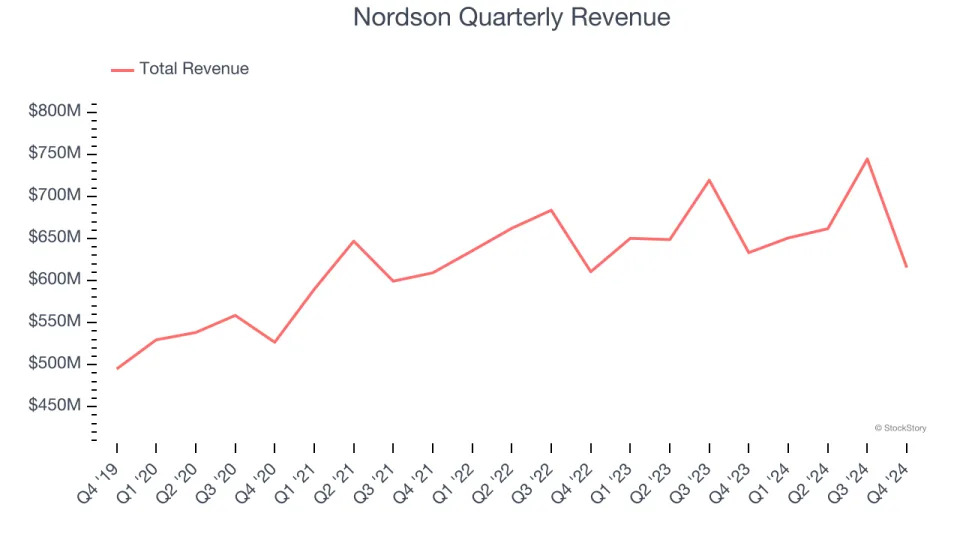
Long-term growth is the most important, but within industrials, a half-decade historical view may miss new industry trends or demand cycles. Nordson’s recent history shows its demand slowed as its annualized revenue growth of 1.5% over the last two years is below its five-year trend.
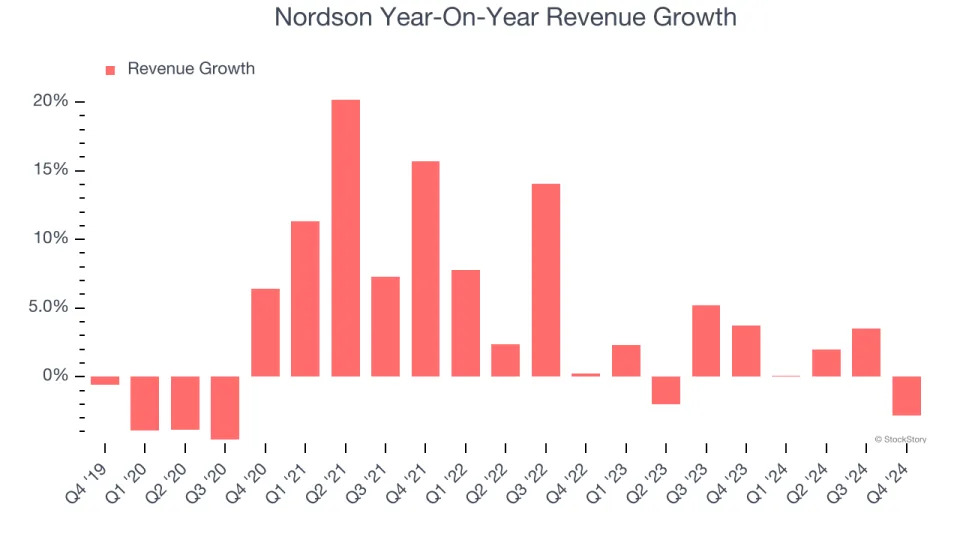
Nordson also reports organic revenue, which strips out one-time events like acquisitions and currency fluctuations that don’t accurately reflect its fundamentals. Over the last two years, Nordson’s organic revenue averaged 3.2% year-on-year declines. Because this number is lower than its normal revenue growth, we can see that some mixture of acquisitions and foreign exchange rates boosted its headline results.
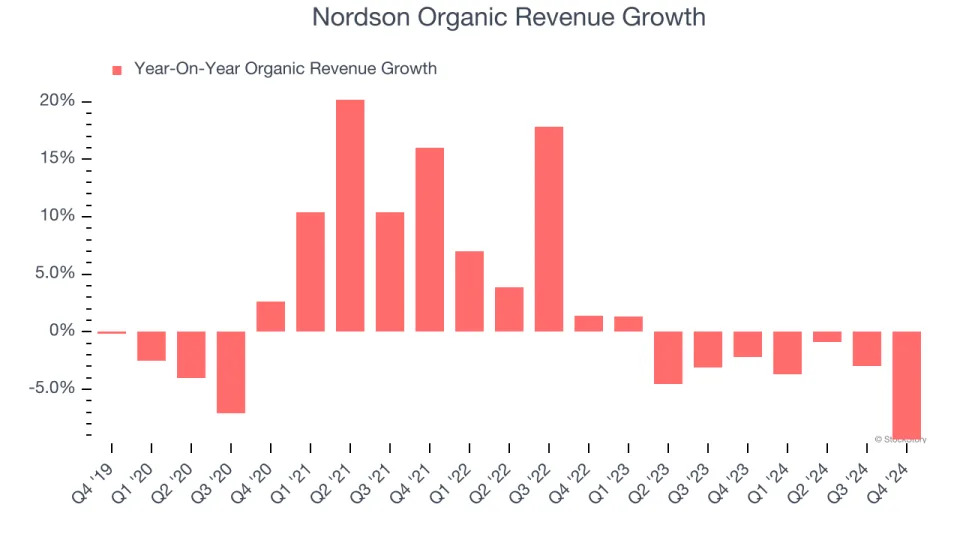
This quarter, Nordson missed Wall Street’s estimates and reported a rather uninspiring 2.8% year-on-year revenue decline, generating $615.4 million of revenue. Company management is currently guiding for a 3% year-on-year increase in sales next quarter.
Looking further ahead, sell-side analysts expect revenue to grow 6.5% over the next 12 months. Although this projection suggests its newer products and services will spur better top-line performance, it is still below average for the sector.
Today’s young investors likely haven’t read the timeless lessons in Gorilla Game: Picking Winners In High Technology because it was written more than 20 years ago when Microsoft and Apple were first establishing their supremacy. But if we apply the same principles, then enterprise software stocks leveraging their own generative AI capabilities may well be the Gorillas of the future. So, in that spirit, we are excited to present our Special Free Report on a profitable, fast-growing enterprise software stock that is already riding the automation wave and looking to catch the generative AI next .
Operating Margin
Operating margin is an important measure of profitability as it shows the portion of revenue left after accounting for all core expenses – everything from the cost of goods sold to advertising and wages. It’s also useful for comparing profitability across companies with different levels of debt and tax rates because it excludes interest and taxes.
Nordson has been a well-oiled machine over the last five years. It demonstrated elite profitability for an industrials business, boasting an average operating margin of 24.6%. This result isn’t surprising as its high gross margin gives it a favorable starting point.
Analyzing the trend in its profitability, Nordson’s operating margin rose by 6.7 percentage points over the last five years, showing its efficiency has meaningfully improved.
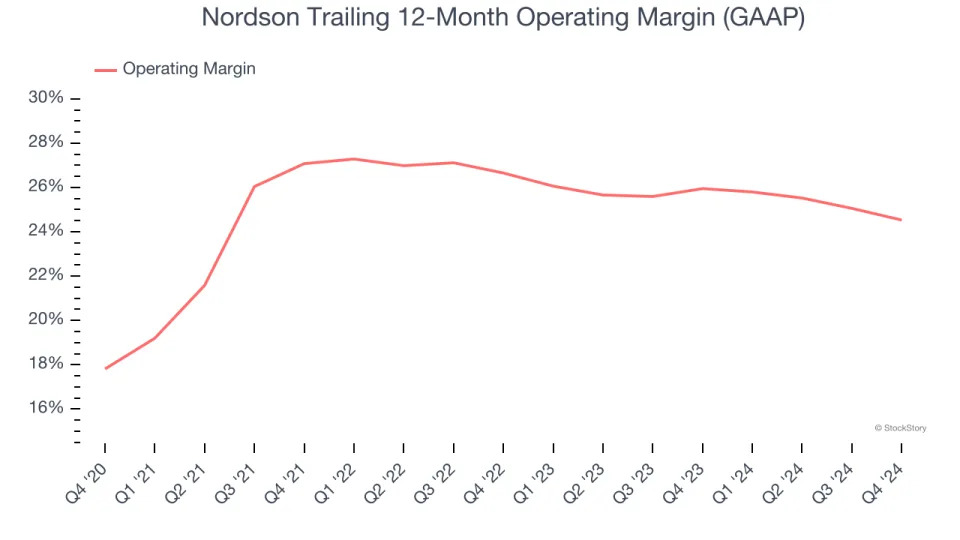
In Q4, Nordson generated an operating profit margin of 22.9%, down 2.3 percentage points year on year. Since Nordson’s operating margin decreased more than its gross margin, we can assume it was recently less efficient because expenses such as marketing, R&D, and administrative overhead increased.
Earnings Per Share
Revenue trends explain a company’s historical growth, but the long-term change in earnings per share (EPS) points to the profitability of that growth – for example, a company could inflate its sales through excessive spending on advertising and promotions.
Nordson’s EPS grew at a decent 9.9% compounded annual growth rate over the last five years, higher than its 4% annualized revenue growth. This tells us the company became more profitable on a per-share basis as it expanded.
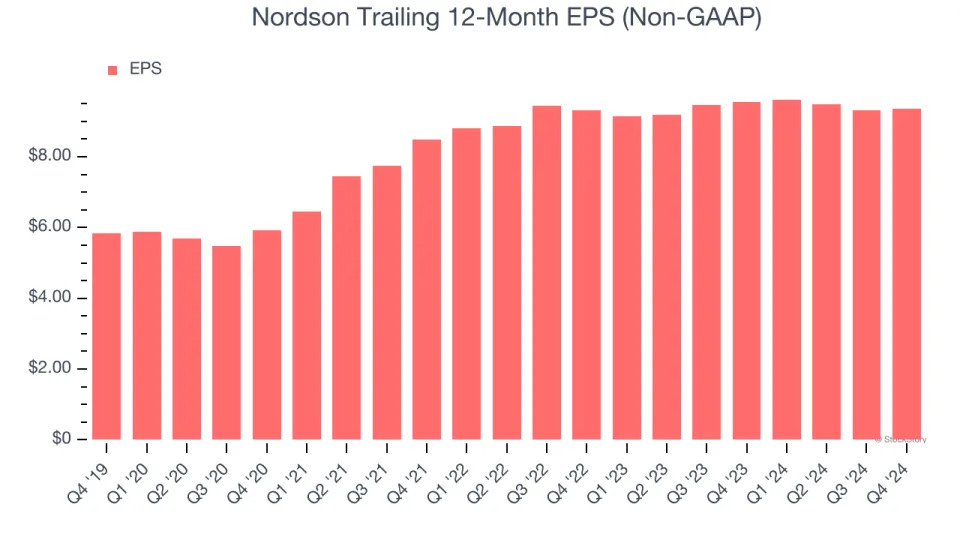
Diving into the nuances of Nordson’s earnings can give us a better understanding of its performance. As we mentioned earlier, Nordson’s operating margin declined this quarter but expanded by 6.7 percentage points over the last five years. Its share count also shrank by 1.8%, and these factors together are positive signs for shareholders because improving profitability and share buybacks turbocharge EPS growth relative to revenue growth.
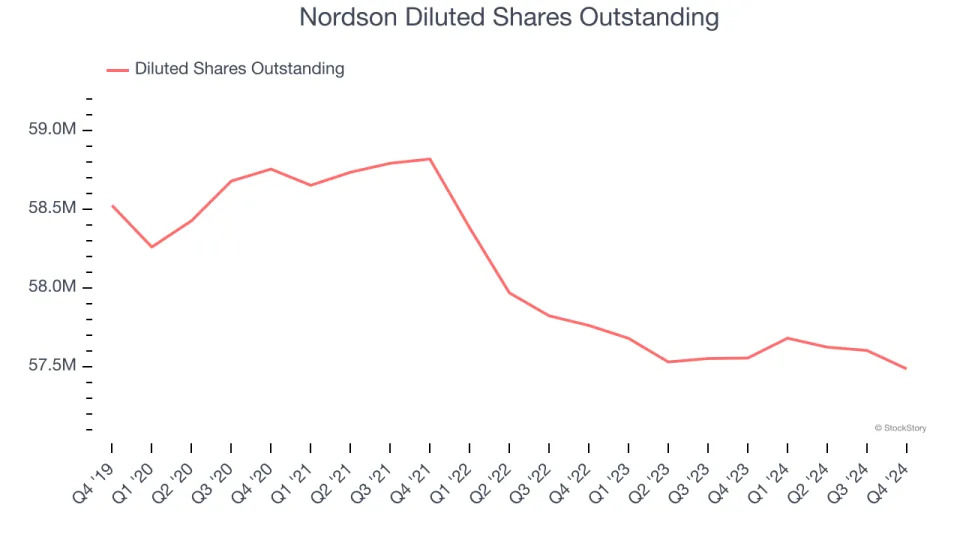
Like with revenue, we analyze EPS over a more recent period because it can provide insight into an emerging theme or development for the business.
For Nordson, EPS didn’t budge over the last two years, a regression from its five-year trend. We hope it can revert to earnings growth in the coming years.
In Q4, Nordson reported EPS at $2.06, up from $2.02 in the same quarter last year. This print was close to analysts’ estimates. Over the next 12 months, Wall Street expects Nordson’s full-year EPS of $9.35 to grow 9.7%.
Key Takeaways from Nordson’s Q4 Results
We struggled to find many positives in these results as the company missed on all key metrics. It also shared revenue and EPS guidance for next quarter that fell short of Wall Street's estimates. Overall, this was a weaker quarter. The stock remained flat at $216.80 immediately following the results.
Nordson’s earnings report left more to be desired. Let’s look forward to see if this quarter has created an opportunity to buy the stock. We think that the latest quarter is just one piece of the longer-term business quality puzzle. Quality, when combined with valuation, can help determine if the stock is a buy. We cover that in our actionable full research report which you can read here, it’s free .





